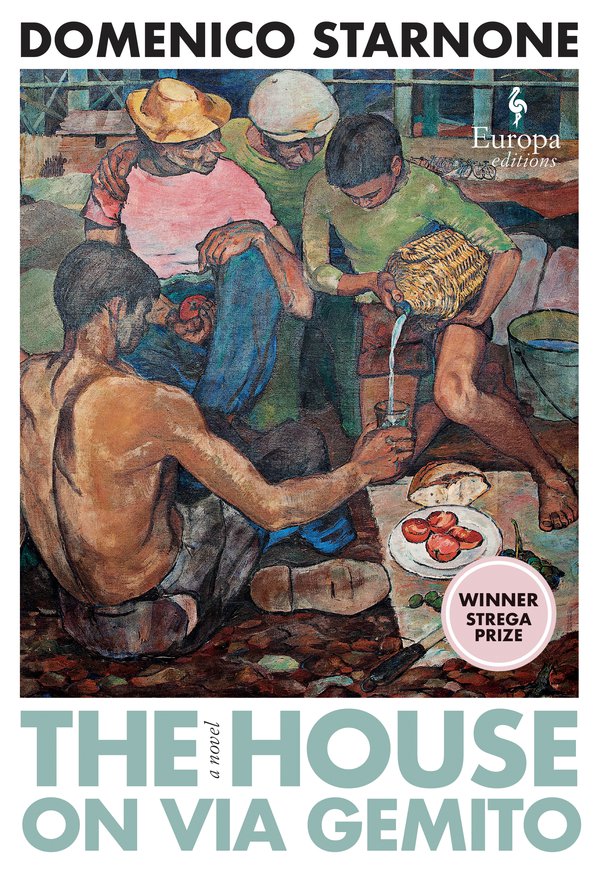Domenico Starnone
Translated by Oonagh Stransky
Europa Editions ($27)
Domenico Starnone’s previously translated novels are psychological studies of repressed father-figures that move at thriller-like speed. In Trust (Europa Editions, 2021), for example, Pietro plays a model father and husband, but only because an ex-girlfriend threatens to reveal an incriminating secret. Trick (Europa Editions, 2018), alternatively, is about a grandfather who is the antithesis of grandfatherly: Daniele, a self-obsessed artist who resents his grandson.
The House on Via Gemito covers similar material, though it is longer and looser than those previous books, and its structure is more triptych than thriller. Supposedly fiction, the novel focuses on a writer named Dominico who is haunted by the “energetic cascade” of his father Federico’s lies, tall tales, and misogynistic slurs. Federico works for the railroad but believes he’s an artistic genius whose “destiny” is continually sabotaged by various “shitheads” and “ball busters”; these include other painters, art critics, and, most significantly, Domenico’s mother, Rusinè. (Starnone’s real-life father, also named Federico, was a minor post-war Italian painter.)
In the first section, “The Peacock,” Domenico follows his younger self, aged four or five, as he walks down a hallway to get his father’s cigarettes. Behind him, his father abuses his mother, “accusing her about the money” and “offending [her] relatives.” This recollection, however, is far from linear; Domenico remembers other incidents at almost every step. In one, his father outsmarts railroad officials to secure company housing for his family. In another, his father boasts about the “great talents” that made him a successful set designer after World War II, praised by American GIs and Hollywood starlets. Yet Domenico keeps returning to that hallway, a memory so urgent and painful that some fifty years later, he still slips into the present tense: “I just heard [my father] yell … and it gave me a start; he’s yelling now; he’s about to yell.”
The centerpiece of Via Gemito is its second section, “The Boy Pouring Water.” Domenico—aged maybe ten—poses for his father, kneeling “in pain” and pretending to pour water into a construction worker’s cup. Meanwhile, his father continues “to paint and talk about himself.” (A detail from the author’s real-life father’s painting, “The Drinkers,” appears on the novel’s dust jacket.) Federico’s family, in other words, pays the price for Federico’s artistic narcissism. Domenico certainly does: In this memory, as in many others, he would rather suffer than “give [his father] any reasons for blaming” him. But also Rusinè: Federico makes her “live … without any great expressions of joy,” and as the novel’s third and final section shows, she downplays a major illness until it’s too late.
Bitterness and futility, not fame and glory, become Federico’s legacies. In one of his frequent asides, Domenico looks at some of his father’s paintings of Rusinè and her family and thinks:
While my memories of them may have been dull, they were still more intense than what the reliable seismograph of art had been able to register … Much more sensitive tools and sophisticated techniques are needed to capture that cluster of voices, gestures, pulsations, instance of illness and health, hiccups, belly laughs, and groans of pain that we conventionally refer to as individual.
Here Domenico doesn’t just question whether his father’s achievements are worth the damage he caused, he questions the very idea of mimetic art—that it captures the reality of physical presence. “I was trying to understand how life decays when we’re overpowered by an obsession for results,” Domenico concludes.
Of course, Starnone does not reject art or craft; anyone who has read his previous novels knows they’re a testament to plot and sentence. Still, as translated by Oonagh Stransky (who has translated Italian works by authors ranging from Eugenio Montale to Pope Francis), The House on Via Gemito serves to show his English readership how much broader his talent is. A memento mori of sorts, the book is a reminder that most of us will only be remembered by how we treated those near to us, and that “living and thinking matter [are] the only set design worth loving.”
Click below to purchase this book through Bookshop and support your local independent bookstore:
Rain Taxi Online Edition Winter 2023-2024 | © Rain Taxi, Inc. 2024

